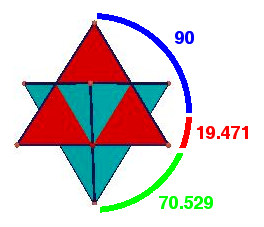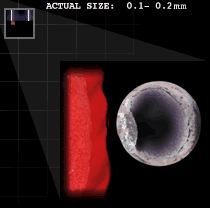

For reference, here are values of some useful physical quantities:
The effective G* induced by the zero point energy core needed
to stabilize a single spatially extended electron is ~ 10^40 G.
G* m / r = e / r G* m = e G* = e/m = 10^42
e Electron charge [Q] 1.381 E-34 cm
m_e Electron mass [M] 9.1095 E-28 gm
6.764 E-56 cm
r_e Electron radius [L] 2.81794 E-13 cm
classical (= alpha(h-bar/(m_e c))
r_es Electron Schwarzschild radius [L] 1.35264 E-55 cm
(= 2G_0 m_e/c^2)
22 orders of magnitude *smaller* than the Planck length
a_0 Bohr radius [L] 0.529177 E-08 cm
( = h-bar^2/(m_e e^2) )
Ken Shoulders and Steve Shoulders said in 1996: "... Highly organized, micron-sized clusters of electrons having soliton behavior ... have been investigated by K. Shoulders since 1980 ... a short Latin acronym has been adopted and the structure is called an EV, for strong electron. Their organizational properties have been theoretically studied and reported by P. Beckmann [... Petr Beckmann, "Electron Clusters," Galilean Electrodynamics, Sept./Oct., Vol. 1, No. 5, pp. 55-58, 1990 ...] and R. Ziolkowski [... Richard W. Ziolkowski and Michael K. Tippett, "Collective effect in an electron plasma system catalyzed by a localized electromagnetic wave," Physical Review A, vol. 43, no.6, pp. 3066-3072, 15 mar., 1991 ...] ... What is seen in the laboratory is an extremely energetic entity ... Measurements ... measuring the charge-to-mass ratio of the structure ...[by]... time-of-flight ... have been made showing there are no included ions to a limit of at least one ion per million electrons. The total number of electrons in a one micrometer diameter EV is 10^11. ...". In 1999 they said: "... Throughout much of this work on EV energetics it has been obvious that we get more energy out of certain experiments than we put in. ...".
In August 2004 e-mail messages about Shoulders's EVOs, Jack Sarfatti said:
"... picture is of a self-assembled spherical shell or maybe a kind of Buckyball of N close-packed electrons each of effective surface area ~ (h/mc)^2. This forms a closed cavity - with some leakage perhaps, but the leakage rate decreases as N increases. Obviously there will be a cavity boundary condition Casimir effect but I am pretty sure it is usually negligible in comparison with my strong gravity effect from Einstein's general relativity. ...... The KEY IDEA is as follows:
1. The repulsive electro-static self energy per unit electron mass for the N poly-electron cluster is V(Coulomb Self-Energy) ~ N^2e^2/mr > 0 where the N electrons are arranged in a mono-layer thin spherical shell of thickness h/mc ~ 10^-11 cm
i.e. Euclidean area of the shell is A = 4pir^2 = N(h/mc)^2 r ~ N^1/2(h/mc) = Schwarzschild radial coordinate if large space warp ... from G* ~ 10^40G at short-range.
That is, N on-mass-shell bare electrons each of radius e^2/mc^2 ~ 10^-13 cm in a soup of virtual plasma of virtual photons and virtual electron-positron pairs - the latter partially condensed as a vacuum condensate!
... a Casimir force ... plays a minor secondary role. The Casimir potential energy per unit electron mass will be of the form V(Casimir) ~ C(hc/mr)N(h/mcr)^2 Where C is a dimensionless coefficient that can be positive or negative ... Note that V(Casimir) scales only as N because it depends on the surface area of the N poly-electron thin shell. This is a boundary effect!
Ignoring rotational and vibrational modes - to be added later. All we have next is the GR correction term ... V(Dark Energy) = c^2/\zpfr^2 a 3D Harmonic Oscillator Potential like a ball in a tunnel through center of Earth
Note that /\zpf > 0 i.e. an anti-gravity repulsive "dark energy" exotic vacuum core that COUNTER-INTUITIVELY BINDS the N electrons into a metastable BOUNDARY WALL THIN POLY-ELECTRON SHELL making the QED Casimir force in the first place ... Adding all three potential energies Coulomb, Casimir & General Relativity with PW Anderson's "More is Different"
V(total) = BN^2(e^2/mr) + CN(hc/mr)(h/mcr)^2 + c^2/\zpfr^2
B is also a dimensionless coefficient The critical point for dynamical equilibrium is dV(total)/dr = 0 i.e. the total acceleration must vanish in metastable equilibrium where r --> r* -BN^2(e^2/mr*^2) - 3CN(hc/mr*^2)(h/mcr*)^2 + 2c^2/\zpfr* = 0
So I do not care about Casimir force, which when N >> 1 is obviously a small perturbation!
We now have a more accurate formula for r*, or rather, if you want to keep r* = N^1/2(h/mc) then you can compute /\zpf.
We also have the stability constraint: d^V(total)/dr^2 > 0
When this constraint is violated WE HAVE WHAT IS BEGINNING TO SUGGEST A BOMB! ...
... you must explain why the boundary forms! You cannot impose it by fiat. The boundary is the thin shell of charge itself of radius a ~ N^1/2(h/mc). If N ~ 10^12 that gives a ~ 10^-5 cm. ... I don't think it works well for 2 electrons. You need, in simplest model, N >> 1 electrons close-packed to form a sphere ...".
My model for EVOs also makes a spherical shell, but it is a two-layer shell, motivated by the formation of a blastocyst two-layer shell in embryology, and it also explains how the door to the high-energy vacuum is opened.
Here is an 8-step description of my model:
1 - A bunch of electrons are zapped in Ken Shoulders's apparatus
with a complicated electromagnetic field.
2 - One of the electrons finds another with opposite spin
and they form a Cooper pair of two electrons
in a dumbbell configuration.
3 - They find another Cooper pair, and the 4 of them form
a double-dumbbell tetrahedral configuration.
4 - The tetrahedron finds (or catalyzes the formation of)
another opposite-oriented tetrahedron, and the 8 of them
form a cube.
5 - Each of the 8 vertices of the cube finds from the cloud
an opposite-spin electron, and the 16 of them look like
Cooper pairs at each of the 8 cube vertices
with the long axis of each pair on a diagonal of the cube.
( At age 4 days, a human embryo consists of a solid ball of 16 cells, called the morula. At the next stage of cell division, the blasocyst forms. Here is a blastocyst image

from http://www.visembryo.com/baby/stage3.html which states: "... Cell division continues, and a cavity known as a blastocele forms in the center of the morula. Cells flatten and compact on the inside of the cavity ... the appearance of the cavity in the center the entire structure is now called a blastocyst. ... two cell types are forming: the embryoblast (inner cell mass on the inside of the blastocele), and the trophoblast (the cells on the outside of the blastocele). ...". )
THE CENTER OF THE CUBE IS A HOLLOW INTERIOR,
with a 2-layer boundary of 8 inner electrons of each Cooper pair
and 8 outer electrons of each Cooper pair.
The 8 inner electrons can be thought of as being bounded by
the 8 outer electrons.
6 - Any energy (kinetic or repulsive electromagnetic) of
the 8 inner electrons confined by the boundary of the 8 outer electrons
is transferred to the Bohm Quantum Potential by the process
described in Bohm's Hidden Variable Paper II, section 5,
(reprinted at page 387 of Quantum Theory and Measurement,
edited by Wheeler and Zurek (Princeton 1983))
in which Bohm says:
"... the PSI-field is able to bring the particle to rest
and to transform the entire kinetic energy into potential energy
of interaction with the PSI-field. ...".
Bohm discusses specifically the situation of
"... a "free" particle contained between two impenetrable and
perfectly reflecting walls, separated by a distance L. ...",
but
perhaps a similar analysis might apply to a spherical cluster.
Bohm goes on to say:
"... at first sight, it may seem puzzling
that a particle having a high energy should be at rest
in the empty space between two walls.
Let us recall, however, that the space is not really empty,
but contains
an objectively real PSI-field that can act on the particle. ...".
7 - The increased energy of the Bohm Quantum Potential is
now enough to open the door to the high-energy vacuum,
which effectively gives the electron configuration
access to conformal degrees of freedom of of vacuum dark energy etc.
8 - The electron double-layer with central vacuum energy configuration,
which is the EVO, then begins to collect the other electrons in
the cloud, making them into Cooper pairs and sticking them into
the sort-of-spherical double-layer.
The outer layer of electrons acts as a protective boundary for
the EVO, because if a hostile electron/positive ion system
attacks the EVO, an outer boundary EVO electron neutralizes
the positive ion and the EVO captures the remaining electron
to replace the boundary electron.
The entire EVO system continues to grow until the electrons
of the cloud are all assimilated into it (about 10^12 electrons
in the case of EVOs manufactured by Ken Shoulders).
Ball lightning can be a lot larger than the size of the Ken Shoulders manufactured EVO because lightning can be more energetic than his machines.
A typical Ball Lightning has r ~ 10 cm, N = 10^21.
Use the hydrogen atom as the basis of comparison
where r ~ 10^-8 cm and N = 1
with self-electrical force ~ 10^+16
compared to
the Ball Lightning self-electrical force 10^42 x 10^-2 = 10^40
in these relative dimensionless units.
That is,
the self-electrical force at the
surface of the Ball Lightning assumed to be in a spherical thin shell
is ~ 10^24 stronger than the electrical force on
the atomic electron in the ground state of the hydrogen atom.
Next consider a single electron as a shell of charge e
at the classical electron radius 10^-13cm.
The relative self-electric force is then 10^+26.
Therefore,
the electrical force of the Ball Lightning is
about 10^14 larger than that on a single electron.
The effective G* induced by the zero point energy core needed
to stabilize a single spatially extended electron is ~ 10^40 G.
That is
the effective Planck length Lp* in
the interior of a single electron is ~ 10^-13 cm.
The effective Planck length in the interior of the Ball Lightning
is therefore ~ 10^-6 cm since G* ~ Lp^*2.
Tony Smith's Home Page - Here is a pdf version of this page.
......